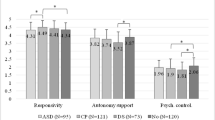Abstract
Self-sufficiency is central to child and family well-being. This report focuses on predictors of adaptive daily living skills (DLS) development in young children with ASD and whether DLS gains predict decreases in parenting stress. Participants were 162 toddlers with ASD and their parents, assessed at 3 annual timepoints. Hierarchical Linear Models showed that age, DQ, and autism symptom severity uniquely predicted initial DLS and DLS growth. Child problem behaviors predicted initial DLS only. DLS was associated with change in parenting stress above and beyond DQ, autism symptom severity, and problem behaviors. Children with lower IQ and more severe symptoms showed slower DLS gains. Given its relation to parenting stress, DLS are an important intervention target in young children with ASD.
Similar content being viewed by others
References
Abidin, R. R. (1995). The parenting stress index professional manual (3rd ed.). Lutz, Florida: Psychological Assessment Resources, Inc.
Briggs-Gowan, M. J., & Carter, A. S. (2006). The brief infant-toddler social & emotional assessment (BITSEA). San Antonio, Texas: Psychological Corporation, Harcourt Assessment.
Carpentieri, S., & Morgan, S. B. (1996). Adaptive and intellectual functioning in autistic and nonautistic retarded children. Journal of Autism and Developmental Disorders, 26(6), 611–620.
De Bildt, A., Sytema, S., Kraijer, D., Sparrow, S., & Minderaa, R. (2005). Adaptive functioning and behaviour problems in relation to level of education in children and adolescents with intellectual disability. Journal of Intellectual Disability Research, 49(9), 672–681.
Estes, A., Munson, J., Dawson, G., Koehler, E., Zhou, X., & Abbott, R. (2009). Parenting stress and psychological functioning among mothers of preschool children with autism and developmental delay. Autism, 13(4), 375–387.
Freeman, B. J., Del’Homme, M., Guthrie, D., & Zhang, F. (1999). Vineland adaptive behavior scale scores as a function of age and initial IQ in 210 autistic children. Journal of Autism and Developmental Disorders, 29(5), 379–384.
Gilham, J. E., Carter, A. S., Volkmar, F. R., & Sparrow, S. S. (2000). Toward a developmental operational definition of autism. Journal of Autism and Developmental Disorders, 30(4), 269–278.
Hauser-Cram, P., Warfield, M. E., Shonkoff, J. P., & Krauss, M. W. (2001). Children with disabilities: A longitudinal study of child development and parent well-being. Monographs of the Society for Research in Child Development, 66, (3, Serial No. 266).
Landry, S. H., Smith, K. E., Miller-Loncar, C. L., & Swank, P. R. (1997). Predicting cognitive-language and social growth curves from maternal behaviors in children at varying degrees of biological risk. Developmental Psychology, 33(6), 1040–1053.
Liss, M., Harel, B., Fein, D., Allen, D., Dunn, M., Feinstein, C., et al. (2001). Predictors and correlates of adaptive functioning in children with developmental disorders. Journal of Autism and Developmental Disorders, 31(2), 219–230.
Lord, C., Risi, S., DiLavore, P. S., Shulman, C., Thurm, A., & Pickles, A. (2006). Autism from 2 to 9 years of age. Archives of General Psychiatry, 63, 694–701.
Lord, C., Risi, S., Lambrecht, L., Cook, E., Leventhal, B., DiLavore, P., et al. (2000). The autism diagnostic observation schedule–generic: A standard measure of social and communication deficits associated with the spectrum of autism. Journal of Autism and Developmental Disorders, 30, 205–223.
Lord, C., Rutter, M., & LeCouteur, A. (1994). Autism diagnostic interview–revised: A revised version of a diagnostic interview for caregivers of individuals with possible pervasive developmental disorders. Journal of Autism and Developmental Disorders, 24, 659–685.
Mullen, E. M. (1995). Mullen scales of early learning. Circle Pines, MN: American Guidance Service, Inc.
Perry, A., Flanagan, H. E., Geier, J. D., & Freeman, N. L. (2009). Brief report: The vineland adaptive behavior scales in young children with autism spectrum disorders at different cognitive levels. Journal of Autism and Developmental Disorders, 39, 1066–1078.
Raudenbush, S. W., & Bryk, A. S. (2002). Hierarchical linear models: Applications and data analysis methods (2nd ed.). Newbury Park, CA: Sage.
Risi, S., Lord, C., Gotham, K., Corsello, C., Chrysler, C., Szatmari, P., et al. (2006). Combining information from multiple sources in the diagnosis of autism spectrum disorders. Journal of the American Academy of Child and Adolescent Psychiatry, 45(9), 1094–1103.
Schatz, J., & Hamdan-Allen, G. (1995). Effects of age and IQ on adaptive behavior domains for children with autism. Journal of Autism and Developmental Disorders, 25(1), 51–60.
Siller, M., & Sigman, M. (2002). The behaviors of parents of children with autism predict the subsequent development of their children’s communication. Journal of Autism and Developmental Disorders, 32(2), 77–89.
Sparrow, S. S., Balla, D. A., & Cicchetti, D. V. (1984). Vineland adaptive behavior scales. Circle Pines, MN: American Guidance Service, Inc.
Sutera, S., et al. (2007). Predictors of optimal outcome in toddlers diagnosed with autism spectrum disorders. Journal of Autism and Developmental Disorders, 37, 98–107.
Tomanik, S., Harris, G. E., & Hawkins, J. (2004). The relationship between behaviours exhibited by children with autism and maternal stress. Journal of Intellectual and Developmental Disability, 29(1), 16–26.
Volkmar, F. R., Carter, A. S., Sparrow, S. S., & Cicchetti, D. (1993). Quantifying social development in autism. Journal of the American Academy of Child and Adolescent Psychiatry, 32, 627–632.
Acknowledgments
Funding was provided by National Institute of Mental Health grant U54 MH 66398 (Helen Tager-Flusberg,Center Principal Investigator, Alice S. Carter, Project Principal Investigator) as well as grants from the National Alliance for Autism Research (Alice S. Carter, Principal Investigator) and the Boston University General Clinical Research Center. We are grateful to the families of the children in this study, whose participation in our project inspires this work and makes it possible.
Author information
Authors and Affiliations
Corresponding author
Additional information
This research was conducted as part of the Studies to Advance Autism Research and Treatment (STAART) center at Boston University.
Rights and permissions
About this article
Cite this article
Green, S.A., Carter, A.S. Predictors and Course of Daily Living Skills Development in Toddlers with Autism Spectrum Disorders. J Autism Dev Disord 44, 256–263 (2014). https://doi.org/10.1007/s10803-011-1275-0
Published:
Issue Date:
DOI: https://doi.org/10.1007/s10803-011-1275-0




